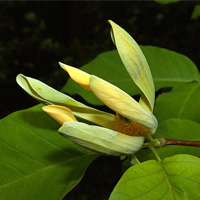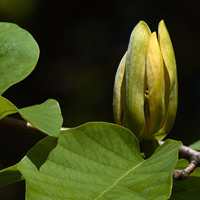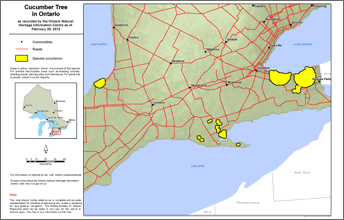Cucumber tree (Species at Risk)
Scientific name: Magnolia acuminata


Status
Endangered
“Endangered” means the species lives in the wild in Ontario but is facing imminent extinction or extirpation.
Date added to the Species at Risk in Ontario List
The Cucumber tree was already assessed as endangered when the Endangered Species Act took effect in 2008.
Read the Assessment Report
What it looks like
The Cucumber Tree can grow as high as 30 metres. The lower branches swoop down from the trunk and then curve upwards. The large, oval-shaped leaves are simple and smooth edged without teeth.
The greenish-yellow solitary flowers grow six to nine centimetres across. The tree is named for the slight resemblance of the immature fruit to a cucumber.
The fruit matures in late summer into a cone-like structure composed of many red, fleshy pods, each containing one to two scarlet seeds.
Where it lives
In Ontario, Cucumber Trees are found in upland moist deciduous or mixed forest habitats, where they grow in rich, well-drained soils, often in headwater areas or on rises within low swampy areas.
Where it’s been found in Ontario
The Cucumber Tree ranges from southeastern New York to northern Georgia, with outlying populations occurring from Florida to southern Ontario.
In Ontario, the Cucumber Tree only occurs in Niagara Region and Norfolk County. Field surveys were conducted in these municipalities during the periods 1998-2001 and 2008-2009.
As a result 18 populations of Cucumber Tree have been identified in Ontario with approximately 170 to 190 mature trees, plus additional saplings.
View a Larger version of this map (PDF)
What threatens it
Habitat fragmentation and small population sizes contribute to the isolation of trees at different sites and may have the effect of reducing cross-pollination, gene exchange and seed dispersal.
The Cucumber Tree is sensitive to prolonged drought conditions as well as overly wet conditions. Indiscriminate logging and recreational activities that involve ATV use also pose a threat.
Action we are taking
Endangered Species and their general habitat are automatically protected
Recovery strategy
A recovery strategy advises the ministry on ways to ensure healthy numbers of the species return to Ontario.
Read the executive summary (September 10, 2010)
Read the recovery strategy (September 10, 2010)
Government response statement
A government response statement outlines the actions the government intends to take or support to help recover the species.
Read the government response statement (June 15, 2011)
Five-Year Review of Progress
A five-year review reports on progress made toward protecting and recovering a species, within five years of publishing a species’ government response statement.
Habitat protection
General Habitat Protection - June 30, 2008
What you can do
Report a Sighting
- The Ministry of Natural Resources and Forestry tracks species at risk such as the Cucumber tree. Report a sighting of an endangered animal or plant to the Natural Heritage Information Centre. Photographs with specific locations or mapping coordinates are always helpful
Volunteer
- Volunteer with your local nature club or provincial park to participate in surveys or stewardship work focused on species at risk.<
Be a good steward
- Private land owners have a very important role to play in species recovery. If you find a Cucumber Tree on your land, you may be eligible for stewardship programs that support the protection and recovery of species at risk and their habitats.
- Pollinators, such as bees, are in steep decline across the globe and they play a key role in the survival of many of Ontario’s rare plants. For information on how you can help scientists monitor pollinator populations in Ontario visit:
www.seeds.ca/proj
Report illegal activity
- Report any illegal activity related to plants and wildlife to
1-877-TIP-SMNR (847-7667) .
Quick facts
- The Cucumber Tree gets its name from its fruit that is pickle-like in shape and changes from green to red as it ripens. Once ripe, the oily, scented seeds are exposed and hang by fine threads. It is assumed that birds are the main consumers and dispersers of these seeds.
- The Cucumber Tree was used by the Cherokee and Iroquois First Nations for a variety of medicinal purposes including alleviating stomach aches and toothaches.
- When pollinating insects first enter the flowers of the Cucumber Tree, they cannot escape because of the tiny wax rollers on the surfaces of the petals that cause them to fall back whenever they try to climb out. It is only after the pollen is released that the petals bend back, releasing the pollen-covered insects.
- The Cucumber Tree is Ontario’s only native Magnolia species.
